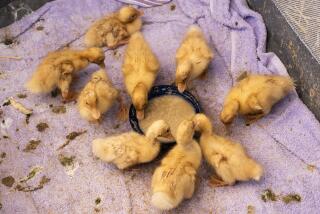Art Ducko : Vermont Artist Is 1st Woman in 40 years to Win Waterfowl Stamp Contest
WASHINGTON — Duck stamp history was made last week in the nation’s capital.
For the first time in 40 years, a woman won a little-noticed but remarkably high-stakes contest to have her design used on a federal stamp that America’s waterfowl hunters must purchase before they go shooting.
In fact, the selection of Vermont painter Nancy Howe’s acrylic of a pair of King Eiders lollygagging in a swamp left some male artists crying canard.
Had the contest run afoul because three of the five judges were female, some of the guys quietly grumbled.
Well, no. The judges couldn’t have known the artists’ gender since the 626 entries were only identifiable by anonymous competition numbers. And besides, after two grueling days of staring at duck depictions--and trying to distinguish whether they were anatomically correct--the weary judges seemed glad to be done with it.
The annual duck stamp contest is the only art competition regularly sponsored by the U.S. government. And while it lacks the notoriety that Sen. Jesse Helms (R-N.C.) has affixed to National Endowment for the Arts grants--there were no nude ducks nor crucifixes in the waterfowl scenery--the competition draws attention for the booty it provides the winner.
Initially, Nancy Howe will get little more than a handshake from the President and a sheet of her stamps from the government.
But the artist, who finds time to paint in between running a sheep farm and looking after her two young sons and physician husband, could stand to make $1 million or more on sales of the 6 1/2-by-9-inch print to hunting aficionados and collectors. The prints sell for about $145 each and last year’s winner has sold the majority of a 20,000-copy limited edition.
But Howe, 40, said prestige, not money, drew her to the event.
“There are a lot of people who might never have known what I do who will now be able to see my other pieces of artwork,” she said. “This will give me plenty of exposure.”
Howe had entered 10 times previously and never even made the finals. But this time instead of producing a design that would look good on a stamp, she said she went for an emotional scene that she might have used in a full-sized painting.
“I spent a lot of time trying to get the feeling of the tundra where the King Eiders roam,” said Howe, whose home is in a rural area not far from Manchester, Vt.
Already, Howe has been swept up by the attention. She has had to fend off art-book publishers and reporters, and to shelve plans to take her children to the Boston aquarium last weekend so she could fly to Washington for a photo opportunity with the President.
When Interior Secretary Manuel Lujan called her from the stage of the department’s cavernous auditorium where a few hundred people had come to watch the final judging, she was stunned by the gales of laughter she heard in the background.
“Who’s there?” she asked Lujan, who explained that their conversation was being broadcast over a loudspeaker. “Oh my goodness,” she said. “This is an early Christmas present!”
The duck stamp program was started in the days of the Dust Bowl by President Franklin D. Roosevelt in conjunction with a Pulitzer Prize-winning illustrator from Des Moines named Jay (Ding) Darling. They teamed up to start the Federal Migratory Bird Hunting and Conservation Act of 1934, fearing a nationwide drought would destroy waterfowl habitats. Since then, sales of stamps have raised about $340 million to buy 4 million acres of wetlands.
The art competition didn’t get going until 1949, but back then only about 100 artists submitted work, mostly in black and white. It wasn’t until the 1960s that artists began cashing in on winning, and only in the 1980s did a larger group of artists--there were years with as many as 1,500 entrants--realize how lucrative the award could be.
Which may explain why, for several nail-biting hours last week, the atmosphere in the red-carpeted auditorium of the Interior Department was a cross between Academy Awards night and the last day of the Olympics. The perimeter of the hushed auditorium was packed with pictures on display and spectators perusing the works. For most of the day, while the judges peered seriously at each entry, the only noise came from piped-in classical music with an occasional jolt by Gershwin.
The judges reviewed quite a range of waterfowl displays. There were sitting ducks, swimming ducks and diving ducks; there were ducks in the marsh and ducks that looked like they could have been surfing off Malibu. The quality also varied from the meticulous to the, well, primitive. Like No. 256, that picture of the swimming duck done in crayon.
Bob Hines, known in some artistic circles as Mr. Duck Stamp because he dreamed up the contest back in the ‘40s when he began working for the Interior Department, recalled touching up a few winners along the way.
“One I had to fix ‘cause the wing was coming out of the belly,” he said chuckling.
There are only a few requirements of the entrants in addition to the $50 contest fee. Their birds must have wings and feathers in the right place; they must be in proportion, and they had better be in their species’ natural setting. (Also, dead ducks were outlawed the year that the winning picture was of an adorable dog with a duck hanging out of his mouth.)
By Wednesday, the judges had narrowed their choices to 50 and then by mid-afternoon were giving the remaining eight flash-card ratings from 1 to 10. The spectators gasped “ooohs” and “aaahs” as each score appeared on a giant screen next to a projection of an entry.
In the end, Howe’s King Eiders broke out of a three-way tie, leaving second-place winner Wilhelm Goebel of New Jersey feeling faint in the back of the auditorium.
“I thought I’d pass out,” he said. “I was so excited to be that close.”
Juston Plummer, a high school football star from Elk Grove, Calif., was flown to Washington to be there for the breathtaking finale because the 17-year-old artist had won what is unofficially known around the Interior Department as the New Ducks on the Block contest.
Plummer’s rendition of two wood ducks was chosen from among 3,000 entries by California youngsters who were asked by the government to submit their best artwork of six species of waterfowl. Plummer’s prize was a visit to the Capital but he had to skip out before the final judging of the duck stamp contest to go judge a contest of his own--of livestock in Kansas City.
“Maybe next year I’ll enter the grown-up contest,” said the 6-foot 4-H Club leader.
Robert Koenke, one of the five judges of what some giddy officials were calling the Art Ducko contest by week’s end, said he expects interest in the contest and wildlife illustrations to increase because so many more hunters are opting for cameras rather than guns.
“There are so many people nowadays who enjoy the simple pleasures of the outdoors as much as they do the hunt,” said Koenke.
For the dozens of wildlife lovers who had flocked to the government center for the contest but still hadn’t quite gotten their fill of ducks, there was one last scene outside the Interior building’s C Street entrance.
There amid the concrete and cars was a large pond graced by none other than a pair of happy-looking mallards known around town as Mr. and Mrs. Duck.
“My little girl has been dying all day to see some live ones,” an artist who had come for the show said as he watched his 3-year-old daughter race around the pond chattering at the ducks.
More to Read
The biggest entertainment stories
Get our big stories about Hollywood, film, television, music, arts, culture and more right in your inbox as soon as they publish.
You may occasionally receive promotional content from the Los Angeles Times.










